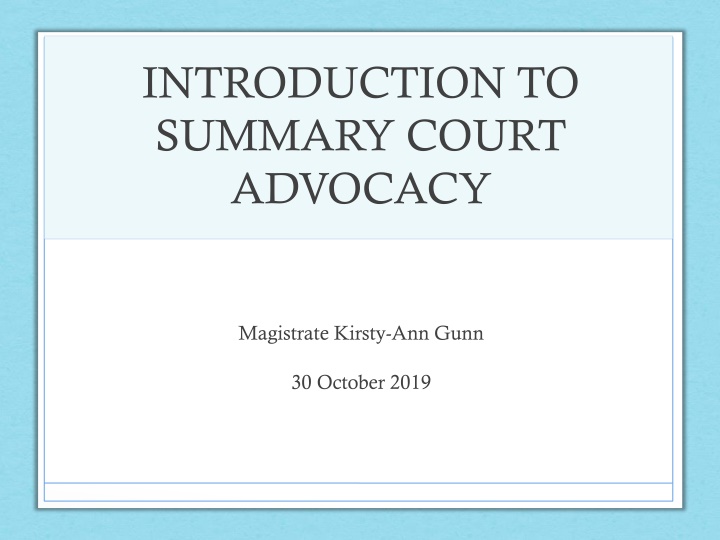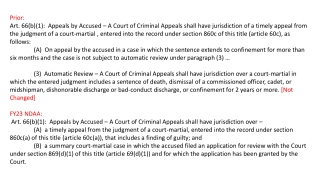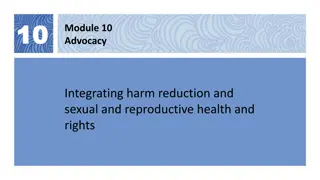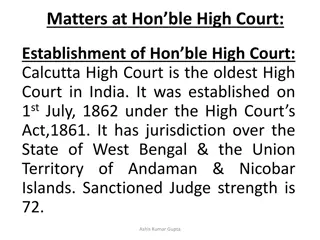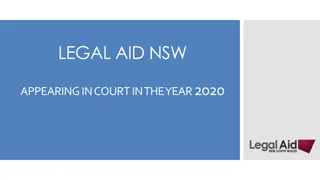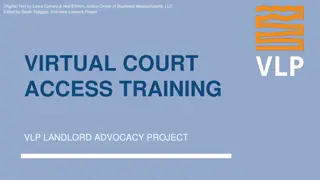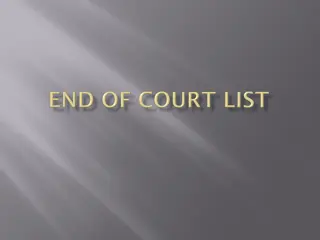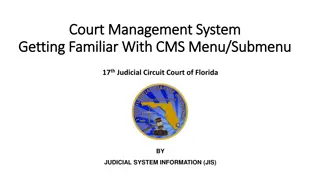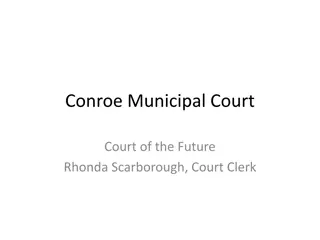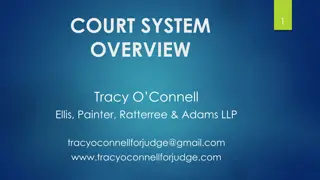Overview of Summary Court Advocacy and Procedures
Introduction to the key aspects of summary court advocacy, including types of cases handled, basic protocols, courtroom etiquette, advocacy tips, and the importance of preparation and knowledge of relevant laws. The guide covers court procedures, dress code, opening and closing court protocols, and emphasizes on the art of advocacy rather than following a fixed scientific method.
Download Presentation

Please find below an Image/Link to download the presentation.
The content on the website is provided AS IS for your information and personal use only. It may not be sold, licensed, or shared on other websites without obtaining consent from the author.If you encounter any issues during the download, it is possible that the publisher has removed the file from their server.
You are allowed to download the files provided on this website for personal or commercial use, subject to the condition that they are used lawfully. All files are the property of their respective owners.
The content on the website is provided AS IS for your information and personal use only. It may not be sold, licensed, or shared on other websites without obtaining consent from the author.
E N D
Presentation Transcript
INTRODUCTION TO SUMMARY COURT ADVOCACY Magistrate Kirsty-Ann Gunn 30 October 2019
The Summary Court Criminal Court Summary Trials (incl. Case Management) Drug Rehabilitation Court Mental Health Court Traffic Court Small Claims Court Family Court (Children & Maintenance) Coroner s Court
The Basics Magistrates are creatures of statute Magistrates do not have any inherent powers to do anything. Show me the Law or case that allows me to do this Our decisions are persuasive only All appeals to the Grand Court - civil matters rehearing Criminal/family on the judgment*
The Basics Dress code: Business attire Court starts at 10 am unless special listing is required/requested Hearing in public or private? If you need to see the Magistrate in Chambers bring your opponent. Address the Magistrate as Your honour Refer to your opponent with respectful terms - e.g. my learned friend or Mr X and Miss Y Be realistic about what you can achieve for your client. Do not mislead the court!!!
Opening Court Marshal: All rise. Advocates stand and magistrate/judge enters Once magistrate/judge at their desk advocates shall bow Marshal: This Honorable Court now commences sitting. God save the Queen Magistrate/judge bows Advocates bow again Magistrates and advocates take their seats
Closing/Adjourning Court Marshal: All rise. Advocates and magistrate/judge stand. Advocates bow Marshal: This Honorable Court is adjourned until 2 pm/Monday morning 10 am. God save the Queen Advocates and magistrate/judge bows Magistrate/judge exits court
ADVOCACY: Art not Science
The Basics Preparation Preparation and more preparation Be on time! Find your client Speak to the other attorney(s)
Bring your Laws Criminal Court: Penal Code Criminal Procedure Code Evidence Law Traffic Court: Traffic Law Family Court: Children Law Children Law (Summary Court) Rules Affiliation Law Maintenance Law
Bring your Laws Small Claims: Summary Jurisdiction Law Summary Court Rules Judicature Law Judgment Debts (Rates of Interest) Rules Grand Court Rules
In Court Order of seniority Make sure the Judge/Magistrate knows your name Introduce the parties Explain the purpose of the hearing Make sure that the Magistrate has received and read the relevant documents before you get started
In Court Do not turn your back on the Magistrate without permission. Stand up when addressing the bench. Watch the Magistrate s pen. Do not interrupt another attorney while they are on their feet.
Litigants in person Overarching duty of fairness e.g. Full and frank disclosure in ex parte applications Duty to disclose unfavourable cases Speak to them Try to avoid legalese Invite the Magistrate to explain an issue if you think the LIP does not understand.
The trial/hearing What is in issue? What do I have to prove/rebut? Open questions vs. leading/closed questions Take notes Know when to sit down Remember the purpose of re-examination Bring spare copies of documents
Open questions start with .. Who Why How When What Where The witness is formulating the answer not you.
Closed/Leading questions Leading the witness to an answer YES or NO Is it not true that Did you not ... Was it not Do you agree Only allowed for uncontested fact/issue (check with your opponent) or in cross-examination
Compound questions When more than one question is combined in what seems to be a single question Answers can be confusing, unclear, misleading and wrong. Is it not correct that the door was locked and it was only when you opened the door that you saw Mr Smith.
Keep it simple When he went, had you gone and had she, if she wanted to and were able, for the time being excluding all the restraints on her not to go, gone also, would he have brought you, meaning you and she, with him to the station?
Putting your case You must give the other party/their witness the opportunity to answer to your client s alternative narrative. Try to avoid . I put it to you that .. I suggest to you that . Totally unnecessary Safety blanket Good advocates put their case through appropriate questions.
Think before you speak So you were gone until you returned? The youngest son, the 20 year old, how old is he? How far apart were the vehicles at the time of collision? Now doctor, isn t it true that when a person dies in his sleep, he doesn t know about it until the next morning?
Oral submissions Be respectful Use signposts/headlining/structure Lead with strongest point Listening can be as important as speaking The Magistrate will prompt you if they understand your point or need further assistance. Do not ignore the Magistrate s question.
Adopting affidavits Establish existence of affidavit Show the witness the affidavit. Identify the signature Confirm the truth of the content Confirm they wish to rely on the affidavit as their evidence Ask any additional/clarifying questions (with leave)
Bail Applications - Prosecution State the grounds of objection (bullet point) Outline the allegation (nature and seriousness of the offence including likely sentence upon conviction) Outline the prosecution evidence (strength of the evidence) Outline any other factors that suggest that the objections are made out (e.g. previous convictions for like offences, history of failing to attend court) Then apply the above to the grounds.
Bail Applications Defence Correct factual inaccuracies Set out client s defence/weaknesses in the Prosecution s case Outline personal circumstances which argue in favour of bail Respond to the objections individually with proposed bail conditions
Food for thought Don t underestimate the power of a pause but don t overuse it Verbal garbage ahh, ummm, thank you Nervous habits Appropriate eye contact (Over) Gesticulating Advocacy; not conversation with tribunal
Written advocacy Stick to deadlines Skeleton argument (bare bones) Written submissions (full submissions) Include authorities Keep it short focus on key points
Forever learning What was my strongest point? What could I have done better? Keep authorities. Ask a colleague for feedback and give feedback Do not become over confident . Learn from more experienced counsel.
Qualities of a good advocate Integrity Professionalism Sound judgment Respect
Useful Resources Cause Lists https://www.judicial.ky/courts/cause-lists-all Summary Court Case Management Hearings https://judicial.ky/wp-content/uploads/practice- directions/PD5of2015-CaseManagement-signed(withform).pdf Small Claims Handbook https://www.judicial.ky/wp-content/uploads/OCC-Small-Claims- Handbook-5th-Edition-2015-Vol1-FINAL.pdf Advocates Gateway https://www.theadvocatesgateway.org/toolkits Mediation
